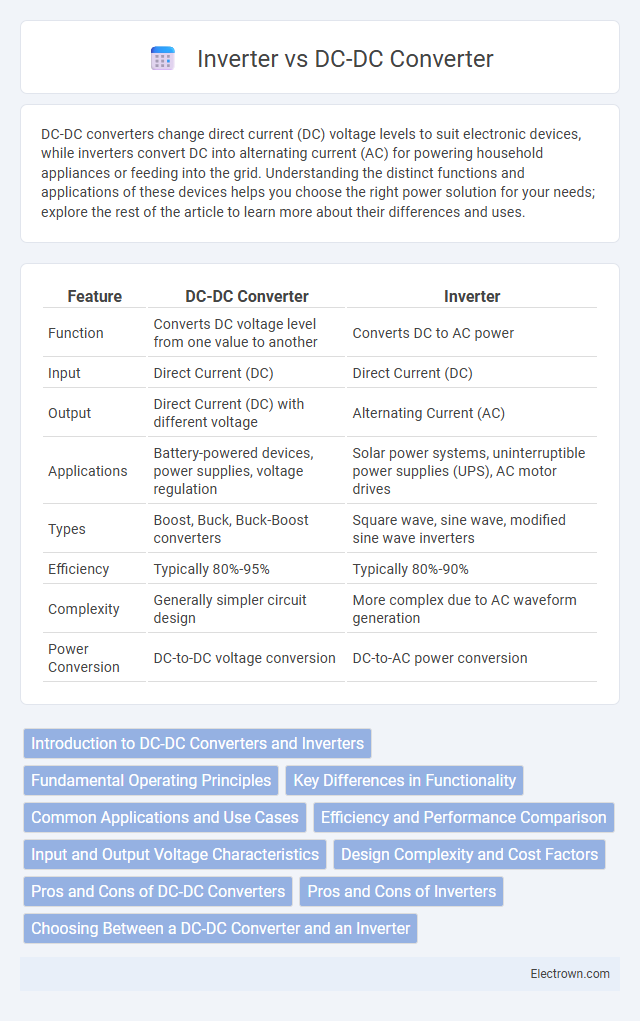DC-DC converters change direct current (DC) voltage levels to suit electronic devices, while inverters convert DC into alternating current (AC) for powering household appliances or feeding into the grid. Understanding the distinct functions and applications of these devices helps you choose the right power solution for your needs; explore the rest of the article to learn more about their differences and uses.
Table of Comparison
| Feature | DC-DC Converter | Inverter |
|---|---|---|
| Function | Converts DC voltage level from one value to another | Converts DC to AC power |
| Input | Direct Current (DC) | Direct Current (DC) |
| Output | Direct Current (DC) with different voltage | Alternating Current (AC) |
| Applications | Battery-powered devices, power supplies, voltage regulation | Solar power systems, uninterruptible power supplies (UPS), AC motor drives |
| Types | Boost, Buck, Buck-Boost converters | Square wave, sine wave, modified sine wave inverters |
| Efficiency | Typically 80%-95% | Typically 80%-90% |
| Complexity | Generally simpler circuit design | More complex due to AC waveform generation |
| Power Conversion | DC-to-DC voltage conversion | DC-to-AC power conversion |
Introduction to DC-DC Converters and Inverters
DC-DC converters efficiently regulate voltage levels by converting a source of direct current (DC) from one voltage level to another, commonly used in battery-powered devices and renewable energy systems. Inverters convert direct current (DC) into alternating current (AC), enabling the operation of AC appliances and integration with power grids. Both components are crucial in power electronics, with DC-DC converters focusing on voltage adaptation and inverters facilitating AC power delivery.
Fundamental Operating Principles
A DC-DC converter regulates the voltage level by switching elements and energy storage components like inductors and capacitors to efficiently step up or step down direct current (DC) voltage. An inverter converts DC power into alternating current (AC) by controlling switches to produce a sinusoidal or modified sine waveform suitable for AC loads. Both rely on semiconductor devices such as transistors or MOSFETs, but DC-DC converters maintain DC output, while inverters generate AC output for grid or appliance compatibility.
Key Differences in Functionality
A DC-DC converter changes a source of direct current (DC) from one voltage level to another, enabling efficient power management in devices like laptops and electric vehicles. In contrast, an inverter converts DC power into alternating current (AC), allowing devices powered by batteries or solar panels to run AC appliances and feed energy into the grid. The primary functional difference lies in voltage conversion within DC systems for DC-DC converters versus the DC-to-AC transformation performed by inverters.
Common Applications and Use Cases
DC-DC converters are commonly used in battery-powered devices, electric vehicles, and renewable energy systems to efficiently step up or step down voltage levels. Inverters find widespread application in solar power systems, uninterruptible power supplies (UPS), and motor drives by converting DC to AC power for household appliances and industrial equipment. Both components are essential in power management systems, with DC-DC converters optimizing voltage regulation and inverters enabling AC power delivery.
Efficiency and Performance Comparison
DC-DC converters typically offer higher efficiency than inverters because they convert voltage levels within the same current type, minimizing energy loss. Inverters convert DC to AC, which involves more complex switching and results in comparatively lower efficiency and increased heat dissipation. Your choice depends on application needs, with DC-DC converters preferred for battery-powered devices and inverters for AC power supply.
Input and Output Voltage Characteristics
A DC-DC converter changes the voltage level within a DC system, converting a source voltage to a different DC output voltage, either stepping it up (boost) or down (buck) while maintaining a stable output. An inverter transforms DC input voltage into AC output voltage, varying frequency and amplitude to match AC power requirements. The input voltage of a DC-DC converter is strictly DC, and the output remains DC but at a different voltage, whereas an inverter's input is DC and output is AC with controlled voltage and frequency characteristics.
Design Complexity and Cost Factors
DC-DC converters typically exhibit lower design complexity and cost due to simpler circuitry aimed at voltage regulation and efficient power transfer within DC systems. Inverters require more complex design elements, including synchronization and control for converting DC to AC with stable frequency and waveform, increasing both development time and component expenses. Cost factors for inverters also rise with advanced features like grid-tie capabilities and harmonic filtering, making them generally more expensive compared to DC-DC converters.
Pros and Cons of DC-DC Converters
DC-DC converters efficiently regulate voltage levels in electronic devices, offering high efficiency, compact size, and precise voltage control with minimal power loss. They are ideal for battery-powered applications but may introduce electrical noise and require complex circuitry for certain voltage conversions. Your system benefits from the stable DC output, but careful design is necessary to manage potential electromagnetic interference and component costs.
Pros and Cons of Inverters
Inverters convert DC power to AC power, making them essential for applications requiring AC output such as household appliances and grid connectivity. They offer versatility in voltage and frequency control but can introduce harmonic distortion and lower efficiency compared to DC-DC converters. Understanding your power requirements helps determine if an inverter's ability to supply AC outweighs potential drawbacks like increased complexity and energy loss.
Choosing Between a DC-DC Converter and an Inverter
Choosing between a DC-DC converter and an inverter depends on the required output type and voltage regulation needs; DC-DC converters efficiently step up or step down voltage within direct current systems, maintaining stable voltage levels for devices like laptops and solar panels. Inverters convert DC to AC power, essential for applications requiring alternating current, such as powering household appliances or feeding solar energy into the grid. Optimal selection hinges on power source compatibility, load requirements, and efficiency targets for applications ranging from portable electronics to renewable energy systems.
DC-DC converter vs Inverter Infographic

 electrown.com
electrown.com